铝行业现状及发展趋势分析38页PPT
- 格式:ppt
- 大小:2.58 MB
- 文档页数:38
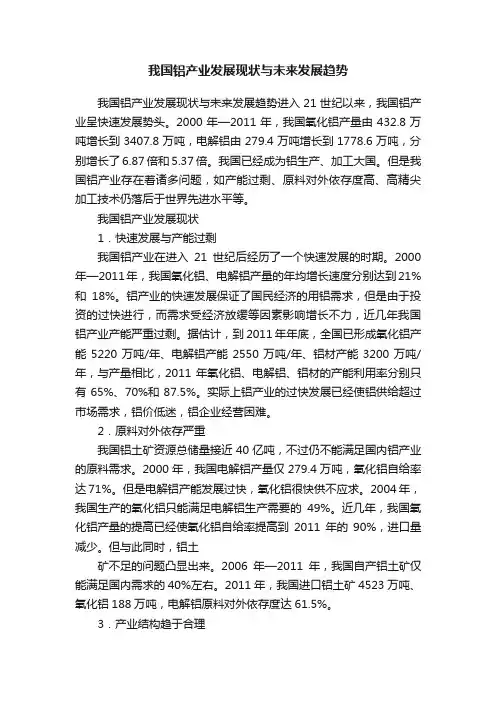
我国铝产业发展现状与未来发展趋势我国铝产业发展现状与未来发展趋势进入21世纪以来,我国铝产业呈快速发展势头。
2000年—2011年,我国氧化铝产量由432.8万吨增长到3407.8万吨,电解铝由279.4万吨增长到1778.6万吨,分别增长了6.87倍和5.37倍。
我国已经成为铝生产、加工大国。
但是我国铝产业存在着诸多问题,如产能过剩、原料对外依存度高、高精尖加工技术仍落后于世界先进水平等。
我国铝产业发展现状1.快速发展与产能过剩我国铝产业在进入21世纪后经历了一个快速发展的时期。
2000年—2011年,我国氧化铝、电解铝产量的年均增长速度分别达到21%和18%。
铝产业的快速发展保证了国民经济的用铝需求,但是由于投资的过快进行,而需求受经济放缓等因素影响增长不力,近几年我国铝产业产能严重过剩。
据估计,到2011年年底,全国已形成氧化铝产能5220万吨/年、电解铝产能2550万吨/年、铝材产能3200万吨/年,与产量相比,2011年氧化铝、电解铝、铝材的产能利用率分别只有65%、70%和87.5%。
实际上铝产业的过快发展已经使铝供给超过市场需求,铝价低迷,铝企业经营困难。
2.原料对外依存严重我国铝土矿资源总储量接近40亿吨,不过仍不能满足国内铝产业的原料需求。
2000年,我国电解铝产量仅279.4万吨,氧化铝自给率达71%。
但是电解铝产能发展过快,氧化铝很快供不应求。
2004年,我国生产的氧化铝只能满足电解铝生产需要的49%。
近几年,我国氧化铝产量的提高已经使氧化铝自给率提高到2011年的90%,进口量减少。
但与此同时,铝土矿不足的问题凸显出来。
2006年—2011年,我国自产铝土矿仅能满足国内需求的40%左右。
2011年,我国进口铝土矿4523万吨、氧化铝188万吨,电解铝原料对外依存度达61.5%。
3.产业结构趋于合理目前,我国铝产业很多技术居世界领先水平。
从电解铝节能技术上看,异型阴极电解槽、新型结构导流槽、电流高效节能控制等技术被广泛采用;大型预焙槽已成主流,世界上第一条500kA预焙槽已在中铝连城分公司投入工业化生产。

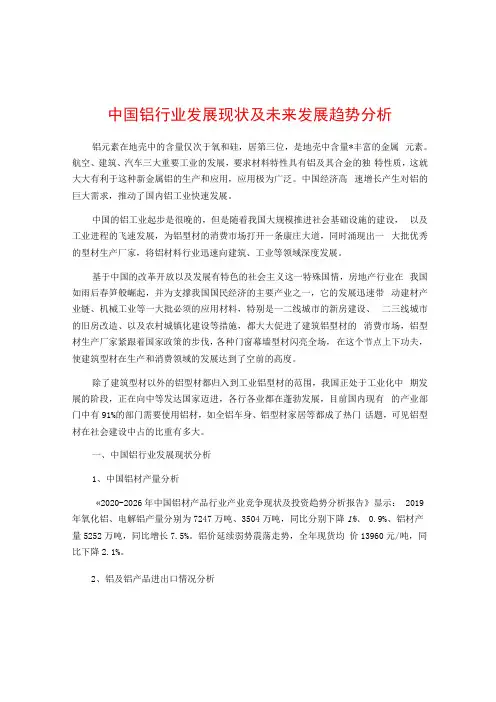
中国铝行业发展现状及未来发展趋势分析铝元素在地壳中的含量仅次于氧和硅,居第三位,是地壳中含量*丰富的金属元素。
航空、建筑、汽车三大重要工业的发展,要求材料特性具有铝及其合金的独特性质,这就大大有利于这种新金属铝的生产和应用,应用极为广泛。
中国经济高速增长产生对铝的巨大需求,推动了国内铝工业快速发展。
中国的铝工业起步是很晚的,但是随着我国大规模推进社会基础设施的建设,以及工业进程的飞速发展,为铝型材的消费市场打开一条康庄大道,同时涌现出一大批优秀的型材生产厂家,将铝材料行业迅速向建筑、工业等领域深度发展。
基于中国的改革开放以及发展有特色的社会主义这一特殊国情,房地产行业在我国如雨后春笋般崛起,并为支撑我国国民经济的主要产业之一,它的发展迅速带动建材产业链、机械工业等一大批必须的应用材料,特别是一二线城市的新房建设、二三线城市的旧房改造、以及农村城镇化建设等措施,都大大促进了建筑铝型材的消费市场,铝型材生产厂家紧跟着国家政策的步伐,各种门窗幕墙型材闪亮全场,在这个节点上下功夫,使建筑型材在生产和消费领域的发展达到了空前的高度。
除了建筑型材以外的铝型材都归入到工业铝型材的范围,我国正处于工业化中期发展的阶段,正在向中等发达国家迈进,各行各业都在蓬勃发展,目前国内现有的产业部门中有91%的部门需要使用铝材,如全铝车身、铝型材家居等都成了热门话题,可见铝型材在社会建设中占的比重有多大。
一、中国铝行业发展现状分析1、中国铝材产量分析«2020-2026年中国铝材产品行业产业竞争现状及投资趋势分析报告》显示: 2019年氧化铝、电解铝产量分别为7247万吨、3504万吨,同比分别下降1%、0.9%、铝材产量5252万吨,同比增长7.5%。
铝价延续弱势震荡走势,全年现货均价13960元/吨,同比下降2.1%。
2、铝及铝产品进出口情况分析2019年铝产品进出口贸易总额263亿美元,同比下降5.5%,其中进口额107 亿美元,同比增长2.5%,出口贸易额156亿美元,同比下降10. 4%o 2019年我国铝材出口 515万吨,同比下降1.6%,出口总额下降7.2%,铝材出口单价同比下跌 5. 7%o3、铝加工现状分析铝加工是将铝锭通过熔铸、轧制(或挤压)和表面处理等多种工艺和流程,生产出各种形态的产品,供交通运输、建筑、包装、电气、机械设备等行业使用。


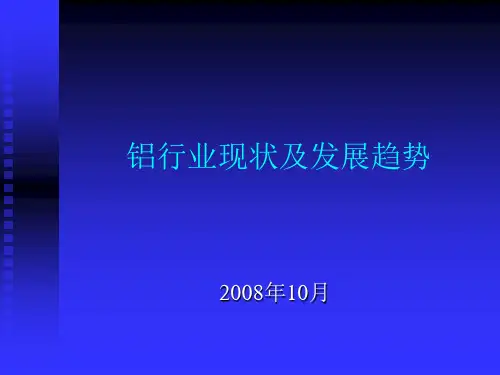
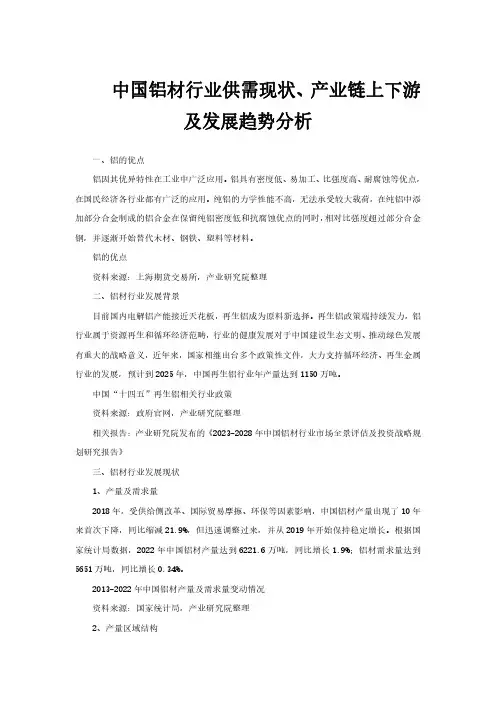
中国铝材行业供需现状、产业链上下游及发展趋势分析一、铝的优点铝因其优异特性在工业中广泛应用。
铝具有密度低、易加工、比强度高、耐腐蚀等优点,在国民经济各行业都有广泛的应用。
纯铝的力学性能不高,无法承受较大载荷,在纯铝中添加部分合金制成的铝合金在保留纯铝密度低和抗腐蚀优点的同时,相对比强度超过部分合金钢,并逐渐开始替代木材、钢铁、塑料等材料。
铝的优点资料来源:上海期货交易所,产业研究院整理二、铝材行业发展背景目前国内电解铝产能接近天花板,再生铝成为原料新选择。
再生铝政策端持续发力,铝行业属于资源再生和循环经济范畴,行业的健康发展对于中国建设生态文明、推动绿色发展有重大的战略意义,近年来,国家相继出台多个政策性文件,大力支持循环经济、再生金属行业的发展,预计到2025年,中国再生铝行业年产量达到1150万吨。
中国“十四五”再生铝相关行业政策资料来源:政府官网,产业研究院整理相关报告:产业研究院发布的《2023-2028年中国铝材行业市场全景评估及投资战略规划研究报告》三、铝材行业发展现状1、产量及需求量2018年,受供给侧改革、国际贸易摩擦、环保等因素影响,中国铝材产量出现了10年来首次下降,同比缩减21.9%,但迅速调整过来,并从2019年开始保持稳定增长。
根据国家统计局数据,2022年中国铝材产量达到6221.6万吨,同比增长1.9%;铝材需求量达到5651万吨,同比增长0.34%。
2013-2022年中国铝材产量及需求量变动情况资料来源:国家统计局,产业研究院整理2、产量区域结构从区域分布看,中国铝材的生产主要集中在华东、华中、华南等地区。
2022年全国铝材产量前三的省份分别是山东省、河南省、广东省,铝材产量分别为1343.03万吨、1094.17万吨、553.07万吨,分别占比21.6%、17.6%、8.9%。
2022年中国主要地区铝材产量占比情况资料来源:国家统计局,产业研究院整理3、进出口中国是世界上最大的铝型材生产和出口国家之一,出口市场主要集中在美国、欧洲和东南亚等地区。
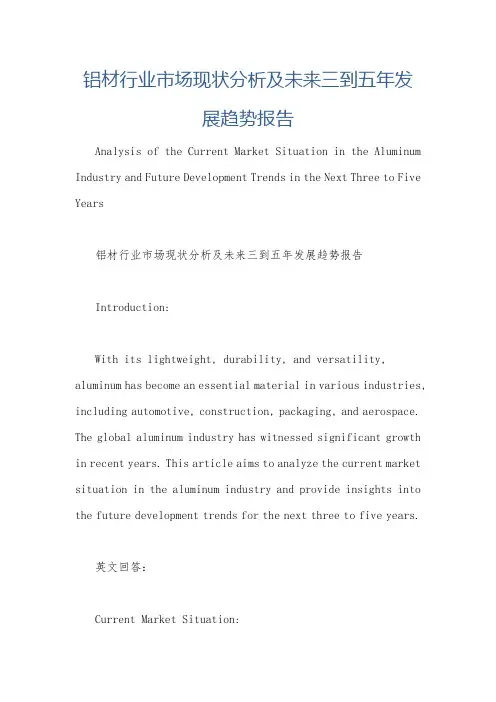
铝材行业市场现状分析及未来三到五年发展趋势报告Analysis of the Current Market Situation in the Aluminum Industry and Future Development Trends in the Next Three to Five Years铝材行业市场现状分析及未来三到五年发展趋势报告Introduction:With its lightweight, durability, and versatility, aluminum has become an essential material in various industries, including automotive, construction, packaging, and aerospace. The global aluminum industry has witnessed significant growth in recent years. This article aims to analyze the current market situation in the aluminum industry and provide insights into the future development trends for the next three to five years.英文回答:Current Market Situation:The aluminum industry has experienced steady growth over the past decade, driven primarily by increasing demand from emerging economies such as China and India. According to industry reports, the global aluminum production reached a record high of 64 million metric tons in 2019. However, the outbreak of the COVID-19 pandemic in 2020 had a significant impact on the industry, leading to a decline in production and demand.The automotive sector is one of the key drivers of the aluminum market. The rise in fuel efficiency standards and the increasing demand for electric vehicles have boosted the use of aluminum in the automotive industry. Additionally, the construction industry has witnessed a surge in demand for aluminum due to its lightweight and corrosion-resistant properties.On the supply side, China is the largest producer of aluminum, accounting for more than 55 of global production. Other major producers include Russia, Canada, and the United Arab Emirates. The market is highly competitive, with numerousplayers striving to gain a larger market share.Future Development Trends:1. Growing Demand in the Automotive Industry: The automotive sector is expected to continue driving the demand for aluminum in the coming years. The shift towards electric vehicles and the need for lightweight materials to improve fuel efficiency will fuel the demand for aluminum components in the automotive industry.2. Increasing Use in Packaging: Aluminum's excellent barrier properties make it an ideal choice for packaging applications. The demand for aluminum packaging is expected to grow due to the increasing preference for sustainable and recyclable materials.3. Sustainable Practices: Environmental concerns and regulations are driving the adoption of sustainable practices in the aluminum industry. Companies are focusing on reducing energy consumption, improving recycling rates, and minimizing waste generation. This trend is expected to continue in thefuture.4. Technological Advancements: The aluminum industry is witnessing technological advancements that aim to improve the production process and enhance the quality of aluminum products. Innovations such as advanced casting techniques, alloy developments, and surface treatments will contribute to the industry's growth.5. Shift towards Lightweight Materials: The demand for lightweight materials, driven by industries such as aerospace and transportation, will continue to increase. Aluminum's high strength-to-weight ratio makes it an attractive choice for these applications.中文回答:市场现状分析:近十年来,铝材行业持续增长,主要受益于中国和印度等新兴经济体的需求增长。